- 09
- Dec
Hozirgi nima?
What is the electric current? First recall, what is the definition of current we have learned?

Oddiy qilib aytganda, o’tkazgichdagi zaryadlangan zarralarning yo’nalishli harakati elektr tokidir.
Agar moddada erkin harakatlana oladigan zaryadlangan zarrachalar bo’lsa, u elektr tokini o’tkazishi, ya’ni elektr tokini o’tkazishi mumkin. O’tkazuvchanlikda ishtirok etadigan bu zaryadlangan zarralar tashuvchilar deb ataladi. Masalan, metallar uchun faqat atomlarning tashqi elektronlari tashuvchi vazifasini bajara oladi.
Elektr tokining ta’rifida “yo’nalishli harakat” ko’pincha noto’g’ri tushuniladi. Ko’pchilik bu ma’lum bir yo’nalishdagi harakatni anglatadi, deb o’ylaydi, albatta! O’zgaruvchan tok zanjiridagi elektronlarning harakat yo’nalishi o’zgarmaydimi?
Aslida, orienteering “tasodifiy harakat” ga nisbatan!
Elektronlar mikroskopik zarralar bo’lgani uchun ular doimo issiqlik harakatida bo’lishi kerak. Issiqlik harakati quyidagi rasmda ko’rsatilganidek, tasodifiy harakatdir. 
Bu harakat aslida juda tez. Masalan, xona haroratidagi metallarda elektron issiqlik harakati tezligi sekundiga yuzlab kilometrlarni tashkil qiladi!
Agar siz ushbu tasodifiy harakatga diqqat bilan qarasangiz, har bir zarrachaning harakat yo’nalishi har qanday vaqtda tasodifiy ekanligini ko’rasiz. Agar siz ushbu zarrachalarning tezlik vektorlarini qo’shsangiz, natija deyarli nolga teng bo’ladi.
Endi o’tkazgichga elektr maydoni qo’shing va elektron tasodifiy harakat asosida yo’nalishli harakatni qo’yadi. Elektr maydonini ma’lum vaqt davomida chap tomonda deb hisoblasak, elektronlarning harakati quyidagicha ko’rinadi. Qizil sharlar kristall panjaradagi metall atomlarini, tez harakatlanuvchi nuqtalar esa erkin elektronlarni ifodalaydi. 
Does it look fast? That’s because electronic movement is really fast! But in fact, the random motion, which accounts for a large proportion of it, does not contribute to the current. When the random motion is eliminated, the rest is just like the slow look below.
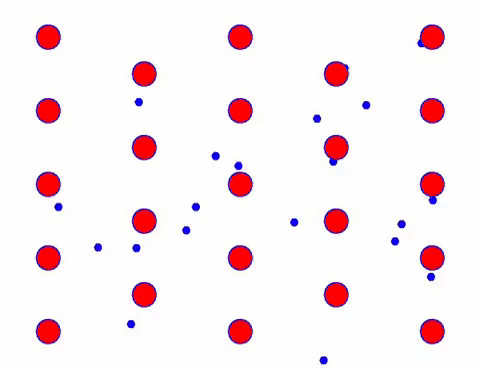
Indeed, the directional movement of electrons is much slower than the speed of thermal movement. This “grinding” movement of electrons is called drift, or “drift”. Sometimes, electrons will run in the opposite direction because of collisions with atoms. But in general, electrons move in one direction.
If the electric field changes direction, the direction of electron drift will also change.
Therefore, this kind of directional movement means that the sum of the speeds of all the electrons participating in the conduction at a certain time is not zero, but is generally in a certain direction. This direction can be changed at any time, and that is the case of alternating current.
Therefore, current is not so much the “directional movement” of electric charge as it is the “collective movement” of electric charge.
The magnitude of the current in the conductor is expressed by the current intensity. The current intensity is defined as the amount of electricity passing through the cross-section of the conductor in a unit time, namely
Biz “intensivlik” so’zini o’z ichiga olgan ba’zi jismoniy miqdorlarni o’rgandik, masalan, elektr maydon intensivligi va magnit induksiya intensivligi. Ular odatda vaqt birligi, birlik maydoni (yoki birlik hajmi, birlik qattiq burchak) uchun taqsimotni ifodalaydi. Biroq, joriy intensivlikdagi “intensivlik” so’zi hududning joriy taqsimotini aks ettirmaydi.
Darhaqiqat, oqimning hududga taqsimlanishi uchun boshqa jismoniy miqdor javobgardir, bu oqim zichligi.
Elektr tokining mohiyati elektr zaryadining yo’nalishli harakati bo’lganligi sababli, oqim intensivligi va drift tezligi o’rtasida ma’lum bir bog’liqlik bo’lishi kerak!
Bu munosabatni olish uchun avvalo tushuncha-tashuvchi kontsentratsiyasini, ya’ni bilan ifodalangan hajm birligidagi tashuvchilar sonini aniqlab olishimiz kerak.
O’tkazgichning kesimi, tashuvchining kontsentratsiyasi, siljish tezligi va zaryadlangan zaryad deb taxmin qilinadi.
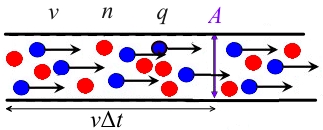
Keyin sirtning chap tomonidagi o’tkazgichdagi zaryad bo’ladi va bu zaryadlar ma’lum vaqt ichida sirtdan o’tadi, shuning uchun
Bu oqim intensivligining mikroskopik ifodasidir.
Oqim zichligi – bu oqimning maydonga taqsimlanishi, shuning uchun oqim zichligi kattaligi, lekin u vektor sifatida aniqlanadi va yo’nalish – musbat zaryadlangan tashuvchilarning siljish tezligi vektorining yo’nalishi, shuning uchun elektronlarning siljishi metallni ushbu Tezlikdan olish mumkin, quyida misol sifatida.
Consider a copper wire, assuming that each copper atom contributes an electron as a carrier. There is 1 mol of copper, its volume is, molar mass is, density is, then the carrier concentration of the copper wire is
Avogadro doimiysi qayerda. Misning zichligi topiladi va uning o’rnini bosish orqali olingan qiymat taxminan birlik / kubometrga teng.
Assuming that the radius of the copper wire is 0.8mm, the current flowing is 15A, =1.6 C, and the drift velocity of electrons is calculated as
Ko’rinib turibdiki, elektronlarning drift tezligi haqiqatan ham juda kichik.
Sxemalarni o’rganuvchilar uchun yuqoridagi oqimning to’liq ta’rifi.
Ammo fizikada oqimning yuqoridagi ta’rifi aslida faqat tor ta’rifdir. Ko’proq umumiy oqimlar elektr zaryadlarining harakati oqim bo’lsa, o’tkazgichlar bilan cheklanmaydi. Masalan, vodorod atomining elektronlari yadro atrofida harakat qilganda, uning orbitasida elektr toki hosil bo’ladi.
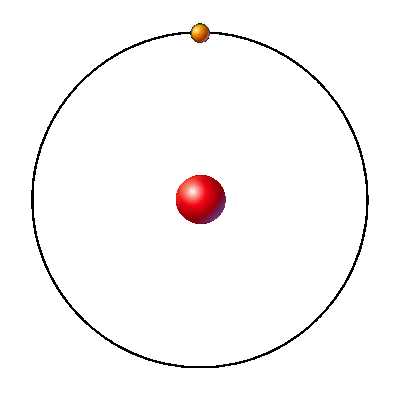
Aytaylik, elektron zaryad miqdori va harakat davri. Keyin har safar o’tganda, pastadirning har qanday kesmasi orqali shunday katta miqdordagi zaryad o’tadi, shuning uchun oqim intensivligi davr, chastota va burchak tezligi o’rtasidagi bog’liqlikka asoslanadi va oqim ham quyidagicha ifodalanishi mumkin.
Yana bir misol uchun, o’z o’qi atrofida aylanadigan zaryadlangan metall disk ham turli radiusli pastadir oqimlarini hosil qiladi.

Bunday oqim oddiy o’tkazuvchanlik oqimi emas va Joule issiqlik hosil qila olmaydi! Haqiqiy sxema hosil qila olmaydi.
Otherwise, would you give me a calculation of how much joule heat is generated per second by the electrons of the hydrogen atom?
In fact, the current in vacuum does not satisfy Ohm’s law. Because, for the electric current formed by the movement of charged particles in the vacuum, the carriers are not collided similar to the lattice in the metal, so the vacuum has no resistance and no conductance.
The movement of electric charges generates electric current, and the electric charge itself excites the electric field. This is easy to cause a misunderstanding. Many people therefore think that the electric field of the charged particles that form the electric current must be exposed. But in fact, for the conduction current in a general conductor, carriers flow on a background composed of a large number of positively charged metal ions, and the conductor itself is neutral!
Biz ko’pincha bunday maxsus oqimni “ekvivalent oqim” deb ataymiz. Bu erda ekvivalent oddiy o’tkazuvchanlik oqimi bilan bir xil asosda magnit maydon hosil qilishini anglatadi!
Eslatma: Bu erda “ekvivalent oqim” ni sxemani tahlil qilishda “ekvivalent zanjir” bilan aralashtirib yubormang.
Aslida, biz magnit maydonni birinchi marta o’rganganimizda, Biot-Saffar qonunidagi elektr toki bu ekvivalent oqimni o’z ichiga olgan umumlashtirilgan elektr toki edi. Albatta, Maksvell tenglamalarida o’tkazuvchanlik oqimi ham umumlashtirilgan oqimga tegishli.
Those who have studied the photoelectric effect know that when the photoelectron drifts from the cathode to the anode, if the influence of air is ignored, this current is caused by the movement of electric charges in the vacuum, and there is no resistance, so it is not restricted by Ohm’s law.
Xo’sh, bu fizikada elektr toki haqida yagona narsami?
Yo’q! Bundan tashqari, ikkita tur mavjud, ya’ni magnitlanish oqimi va joy almashish oqimi.
Ular, shuningdek, ikkita ekvivalent oqim bo’lib, ular nomidan ko’rinib turibdiki, magnitlanishni tushuntirish uchun ham kiritilgan. Boshqacha qilib aytganda, ular hozirgi “zaryad harakati” ning asosiy xarakteristikasidan ajralib chiqdilar!
That’s amazing! There is no electric charge movement, so why can it be called an electric current?
Don’t worry, and listen to me slowly.
Keling, avval magnitlanish oqimini ko’rib chiqaylik.
It was found that magnetism is caused by the movement of electricity (not considering the explanation of magnetism by the intrinsic properties of spin for the time being). In order to explain natural magnetism, French physicist Ampere put forward the hypothesis of “molecular circulation”. 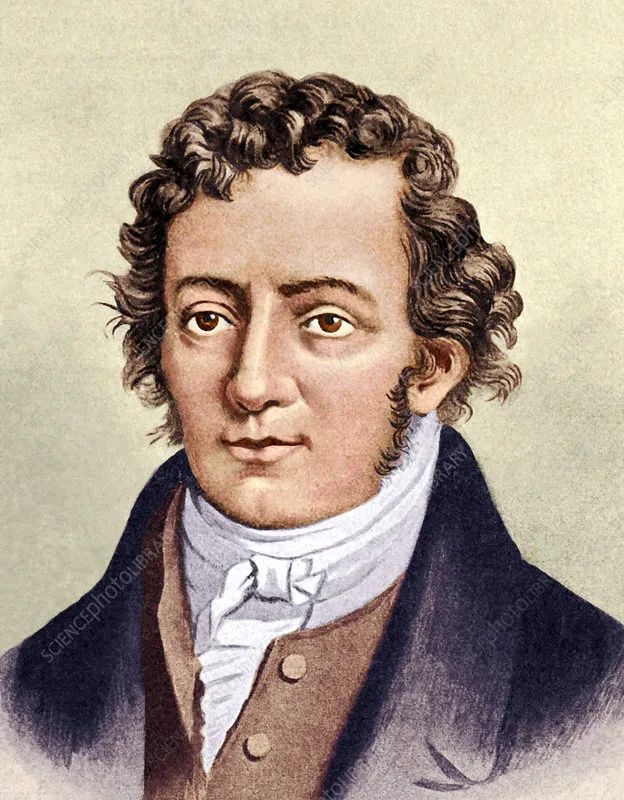
As shown in the figure below, any atom or molecule can be regarded as having an electric charge rotating around the center, forming a tiny loop current, that is, “molecular circulation”.
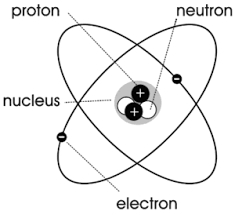
Elektr toki magnit maydonni qo’zg’atadigan qonunga ko’ra, bu molekulyar aylanish magnit moment deb ataladigan jismoniy miqdorni hosil qiladi. Uning o’lchami molekulyar sirkulyatsiya bilan o’ralgan maydonni molekulyar aylanishning ekvivalent oqimiga ko’paytiradi va uning yo’nalishi aylanish yo’nalishi bilan o’ng qo’lda spiral munosabatda bo’ladi, ya’ni
Obviously, the direction of the magnetic moment is exactly along the direction of the magnetic field formed by the circulating current
. 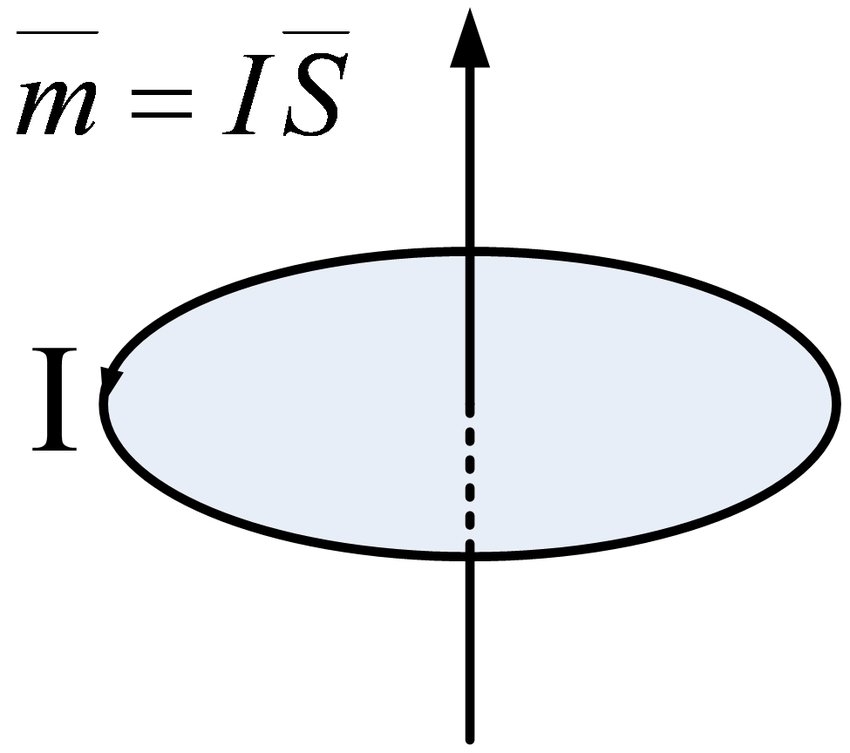
Under normal circumstances, the arrangement of the molecular circulation of a substance is chaotic, so the substance is not magnetic, as shown on the left side of the figure below. When subjected to an external magnetic field, these molecular circulations will be approximately neatly arranged. As shown on the right side of the figure below, their magnetic moments are arranged in one direction as much as possible, just like countless small magnetic needles gathered together to form a total magnetic field, and the whole material composed of them becomes magnetic.
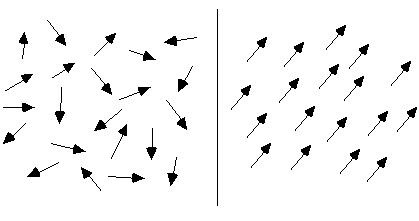
Aytaylik, silindrsimon magnit mavjud bo’lib, ichki molekulyar sirkulyatsiya aniq tartibga solingan va har bir molekulyar sirkulyatsiyaning magnit kesimining chetidagi bo’limlari bir-biriga bog’lanib, quyidagi rasmda ko’rsatilganidek, katta sirkulyatsiya hosil qiladi. 
Shunga asoslanib, biz shtrixli magnitni energiya bilan ta’minlangan solenoidga o’xshash deb o’ylashimiz mumkin. Boshqacha qilib aytganda, magnit yuzasida chigallashgan ko’rinmas oqim mavjud! Bunday oqimni ulash va ishlatish mumkin emas. U magnitning yuzasi bilan chegaralangan. Biz uni “bog’lash oqimi” yoki “magnitlashtiruvchi oqim” deb ataymiz.
Shuning uchun magnitlanish oqimi oqimdir, chunki u haqiqiy elektr zaryadlarining harakatidan hosil bo’lgan oqim bilan bir xil bo’lib, magnit maydonni ekvivalent hosil qilishi mumkin!
Keling, siljish oqimini yana ko’rib chiqaylik.
Amper halqa teoremasiga ko’ra, yopiq yo’lda magnit maydon kuchining integrali shu yo’l bilan chegaralangan istalgan egri sirtdagi tok zichligi oqimiga teng bo’ladi, ya’ni bu teorema matematikada Stoks teoremasi deb ataladi. Har qanday yopiq yo’l bo’ylab vektorning integrali uning yopiq yo’l bilan chegaralangan har qanday sirtga (bu erda) jingalak oqimiga teng bo’lishi kerakligini aytadi.
Matematik teorema bo’lgani uchun u doimo to’g’ri bo’lishi kerak, chunki matematika aksiomalarga asoslangan mantiqiy tizimdir.
Shuning uchun, Amper pastadir teoremasi doimo amal qilishi kerak!
However, the talented Scottish physicist Maxwell discovered that when faced with an unstable current circuit, the Ampere loop theorem was contradictory.
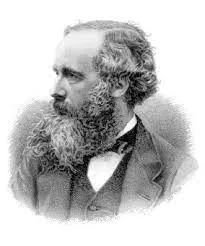
The typical unstable current occurs during the charging and discharging of the capacitor. As shown in the figure below, there is an unstable current during the short period of capacitor charging.
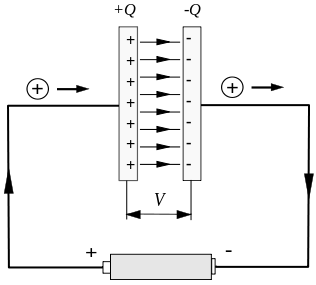
But the circuit is disconnected between the capacitor plates, which will cause a serious problem.
Suppose we consider a closed path that bypasses the wire, as shown in the figure below, the circle marked by C, and the curved surface with it as the boundary can be arbitrarily selected. In the figure, the circular plane enclosed by C itself and across the capacitor are selected. The curved surface of the left plate. 
Dumaloq sirtga ko’ra, egri sirtga ko’ra, lekin magnit maydon kuchining halqa integrali sifatida uning qiymatini aniqlash kerakligini ko’rish mumkin!
Qanday qilish kerak?
Maksvell Amper halqa teoremasini o’rnatish kerak deb hisoblaydi. Endi muammo bor, chunki oqimning bir qismi biz tomonidan ilgari kashf etilmagan bo’lsa kerak, lekin u mavjud!
Xo’sh, oqimning bu qismini qanday topish mumkin?
Muammo plitalar orasida bo’lgani uchun, plitalar orasidan boshlang.
Through analysis, Maxwell found that regardless of charging or discharging, there is a physical quantity between the capacitor plates at all times that is synchronized with the magnitude and direction of the current. It is the time derivative of the flux of the electric displacement vector, that is, it is defined as the displacement current.
Agar bu qism oqimning ilgari kashf etilmagan qismi deb hisoblansa, to’liq oqim hozir. Ya’ni, plitalar orasidagi sxema uzilgan bo’lsa-da, elektr siljish oqimining lotin va oqim yig’indisi birgalikda, bir butun sifatida , Har doim oqimning uzluksizligini ta’minlang.
Going back to the previous contradiction, we now know that, according to the requirements of Stokes’ theorem, when calculating the flux of current density for a closed surface, the density of displacement current should also be considered, that is, the complete ampere loop theorem is therefore, By “discovering” this new current component, the crisis of the Ampere Loop Theorem is resolved!
Bu yerda “kirish” emas, balki “kashfiyot” qo’llanilishi sababi. Shuni ta’kidlashni istardimki, bunday oqim matematik kompensatsiya emas, balki haqiqiy narsa, lekin u ilgari kashf etilmagan.
Why does it exist in the first place? Because it acts as an electric current, like a conduction current, it excites a magnetic field equivalently, except that there is no movement of electric charges, no wire is required, and no Joule heat can be generated, so it has been ignored!
Ammo u aslida o’z-o’zidan mavjud, shunchaki past profilni saqlang, u doimo u erdagi magnit maydonni jimgina hayajonga solib turardi!
Boshqacha qilib aytganda, biz magnit maydonga duch kelganimizda, oqimning asl ta’rifi juda tor. Elektr tokining mohiyati elektr zaryadining harakati emas, u magnit maydonni qo’zg’atishi mumkin bo’lgan narsa bo’lishi kerak.
Hozirgacha tokning bir necha shakllari joriy qilingan. Ularning barchasi ob’ektiv ravishda mavjud va ularning umumiy tomoni shundaki, barcha oqimlar magnit maydonni teng darajada qo’zg’atishi mumkin.
